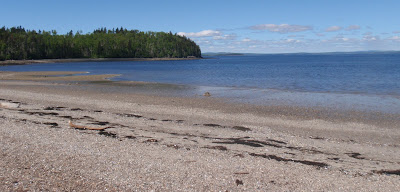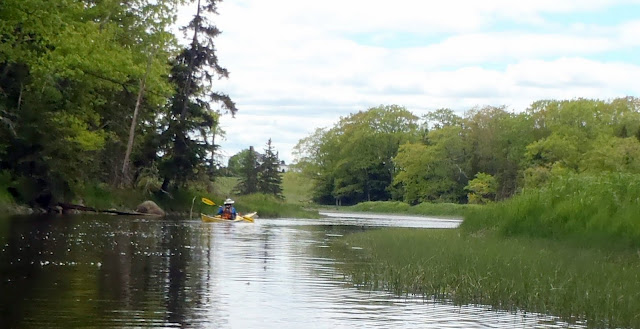Basics: Gould’s Landing off Essex Street in Orono. Sufficient parking, two portapotties, picnic tables, ramp and a small beach. Visiting the southern islands is about a 4 mile route.
We’ve spent much of the week scraping, scrubbing and painting, and then Saturday we had to re-ditch our road. Between those aches and bruises from rescue practice we weren’t up for much but a gentle paddle on Pushaw.
![]()
Pushaw Lake, which may have been named for a French family living on its shores(Pouchaird), is roughly 7 miles long and one mile wide. It gets very busy on weekends. Gould’s Landing, with its tiny beach, one of the only free public beaches near Bangor, is especially crowded. But, with temps in the mid 60’s and rain due, on this Sunday morning most of the folks stayed home.
We headed out first for Moose Island, one of two islands which people land on regularly. Many of the other islands on the lakes have cottages and are private property. Pushaw Lake is lined with camps, tiny homes whose land is measured in square feet. (In Maine ‘camp’ refers to anything from a primitive shack in the woods to a small cozy house; ‘cottages’ refer to estates built down by the ocean.)
But on the Orono shore there is a long undeveloped stretch, and that was the backdrop for our paddle.
We poked around Moose and found visual beauty in plants near the shoreline, enhanced by aroma of cedar and maple trees.
Next it was off to paddle by Ram and Dollar. From there, out to Hardwood, the second island which people land on.
Then back by Dollar and over to Mouse. On Mouse three cormorants hung out high in a tree.
All in all it was a fairly pleasant trip. The one downside was some truly disgusting trash at the landing. Orono has improved Gould’s Landing quite a bit in recent years, adding tables, trash cans, portapotties and a nature trail. Knowing that mothers bring small children there, I felt compelled to pull out my latex gloves and clean up, but it was disheartening. Between the lazy pet owner, unconcerned adult and whoever used the Penobscot River as a dumping ground for their wood chipper, I’m ready for a full fledged "people who ruin it for others" rant.
We’ve spent much of the week scraping, scrubbing and painting, and then Saturday we had to re-ditch our road. Between those aches and bruises from rescue practice we weren’t up for much but a gentle paddle on Pushaw.
Pushaw Lake, which may have been named for a French family living on its shores(Pouchaird), is roughly 7 miles long and one mile wide. It gets very busy on weekends. Gould’s Landing, with its tiny beach, one of the only free public beaches near Bangor, is especially crowded. But, with temps in the mid 60’s and rain due, on this Sunday morning most of the folks stayed home.
We headed out first for Moose Island, one of two islands which people land on regularly. Many of the other islands on the lakes have cottages and are private property. Pushaw Lake is lined with camps, tiny homes whose land is measured in square feet. (In Maine ‘camp’ refers to anything from a primitive shack in the woods to a small cozy house; ‘cottages’ refer to estates built down by the ocean.)
But on the Orono shore there is a long undeveloped stretch, and that was the backdrop for our paddle.
We poked around Moose and found visual beauty in plants near the shoreline, enhanced by aroma of cedar and maple trees.
Next it was off to paddle by Ram and Dollar. From there, out to Hardwood, the second island which people land on.
| A thin line of trees marks a harbor on Hardwood |
Then back by Dollar and over to Mouse. On Mouse three cormorants hung out high in a tree.
All in all it was a fairly pleasant trip. The one downside was some truly disgusting trash at the landing. Orono has improved Gould’s Landing quite a bit in recent years, adding tables, trash cans, portapotties and a nature trail. Knowing that mothers bring small children there, I felt compelled to pull out my latex gloves and clean up, but it was disheartening. Between the lazy pet owner, unconcerned adult and whoever used the Penobscot River as a dumping ground for their wood chipper, I’m ready for a full fledged "people who ruin it for others" rant.
| Chips on the Penobscot: these have been bobbing back and forth with the tide for over a week. |
























